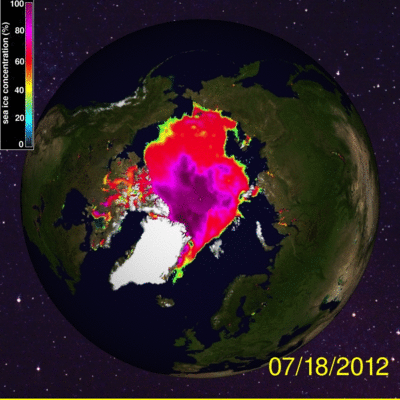What is sea ice first melt? Best explained by observations:

March 9 2013, a diurnal variation of the sea ice horizon. This is newly formed first year sea ice from the worse melt in sea ice history in 2012. At left the horizon was lowest, following sun ray bombardment at local apparent noon, this happens when the thermal structure of the sea surface to air interface has an isothermal structure. the air immediately above the ice has a lapse rate nearing 0 degrees C/km. As the evening approached concurrently with the lower sun elevation something not
immediately obvious happens, the horizon rose( middle) by a very significant 1.3' (minutes of arc), this would be if the sea ice physically rose 18.6 meters 40 kilometers away. At sunset (right picture) the horizon didn't rise much further in fact dropped a bit, this means the ice was not so thick. The sea ice core temperature could be very much colder, 11' of arc horizon boost was measured once in the same location.
Sea ice core temperature is an important player in sea ice horizons. Thermodynamically,
with lab conditions, air cools faster than ice (in a dark place, like a cloudless night), when not warmed by sun rays, this would lower the horizon if so. But the ice usually has a significantly colder core than its surface warmed by solar radiation. This core cools the noon warmed sea ice surface faster than the air, which in turn cools the interface air faster than the layer of air just above it. A colder layer of air under a warmer one is called an inversion. An observer can "see" this inversion by studying the horizon.
A very old sea ice pan, say 10 meters thick, has a colder core temperature even outlasting the Arctic summer (the ice survives!), thicker sea ice can have much colder core temperature, and conversely, the horizon may rise. The opposite is so, the thinner the sea ice , the warmer the core and the lesser the horizon shift:

March 9 2016, the sea ice horizon did not move despite partially sunny conditions (3' of arc), and some haze, the same thing happened on sunny March 7. Therefore , this is first melt conditions. Whereas the horizon like this has not been measured since there was open water last September and or thin sea ice last October .
First melt in early March?
Repeatable horizon measurements at the same altitude as when open water temperatures was equal to the air is the definition of the first melt, When so, accretion stops, and the bottom may melt since sea water is as warm as bottom salty sea ice.
2015 first melt was March 26, 2014 April 10, 2013 March 23, 2012 March 17, 2011 April 15 and 2010 March 19.
Implications
Without a doubt 2016 has the thinnest ice, thinner than 2012. And the sea ice causing the least variations in March, the coldest historical sea ice period. If there is no massive cooling about, this thinner sea ice means earliest arrival of melt ponds with earliest break ups all over the Arctic. If we follow the South Cornwallis Island record carefully, the second earliest first melt year was 2012. WD March 9,2016




























